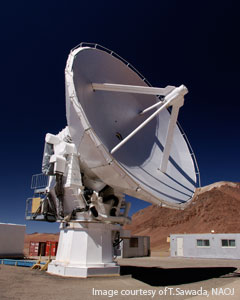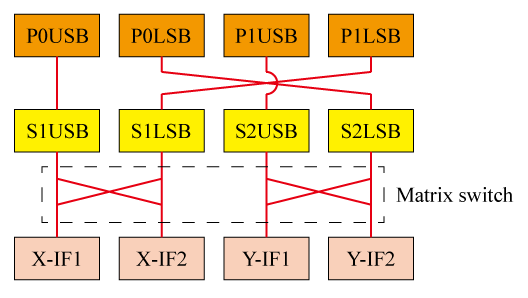Instrumentation Overview
Updated on November 1, 2017

The Atacama Submillimeter Telescope Experiment (ASTE) is a project to promote ground-based observations at submillimeter wavelengths with a telescope in the Atacama desert in Chile, operated by the Chile Observatory of the National Astronomical Observatory of Japan (NAOJ), under the collaboration with University of Chile and Japanese Universities including University of Tokyo, Osaka Prefecture University, Ibaraki University, Hokkaido University, Keio University, and Joetsu University of Education. The ASTE observatory consists of the high-precision 10 m dish for submillimeter wavelengths, SIS mixer receivers for heterodyne observations, IF transmission system, digital spectrocorrelator, continuum backend, computers for monitor and controls of observations, and infrastructure including power generators, satellite communication system, dedicated rooms equipped with air conditioners, and so on.
- The location of the ASTE telescope
-
- West longitude 67d 42m 11.89525s
- South latitude 22d 58m 17.69447s
- Altitude: 4861.9 m
- Pinpointing ASTE on Google Map
The Telescope
Visit the URL below to find out the descriptions on the telescope performance (angular resolution, main-beam efficiency, pointing accuracy, etc.) and pointing strategy.
Receivers
Operating and Upcoming Instruments
Here is a summary for the current status of the receivers that ASTE is/will be equipped with. A dual-polarization side-band separating (2SB) mixer receiver for the 350 GHz band, DASH 345 , and a cartridge-type dual-polarization side-band separating (2SB) mixer receiver for the 490 GHz band, ASTE Band 8 (ALMA Band-8 Qualification Model) are currently available. Click the instrument name to find out the specifications and performance of each receiver.
| Instrument | Type | Frequency (GHz) |
HPBW (arcsec) |
Npix | Band width (GHz) |
Back-end Option |
Status | Note |
|---|---|---|---|---|---|---|---|---|
| DASH345 | Heterodyne | 321-376 | 22 | 1 | IF=4.0-8.0 | WHSF | Open | |
| ASTE Band8 | Heterodyne | 387-498 | 17 | 1 | IF=4.0-8.0 | WHSF | Open | |
| CATS345 | Heterodyne | 324-372 | 22 | 1 | IF=4.5-7.0 | WHSF | N/A | |
| TES Camera | Bolometer | 270 | 28 | 169 | ~50 | None. | N/A | The status is for Phase I. |
| 350 | 22 | 271 | ~30 |
- DASH 345

- A two-sideband dual-polarization heterodyne receiver operating at frequencies of 321-376 GHz.
- ASTE Band 8

- A two-sideband dual-polarization heterodyne receiver operating at frequencies of 400-500 GHz.
- TES Camera

- A large bolometer array simultaneously imaging the sky in the two bands (1100 and 850 micron for Phase I and II; 850 and 450 micron for Phase III).
Decommissioned Instruments
The decommissioned instruments are listed below. Note that these instruments are currently not available.
- CATS 345
- See Inoue et al. (2008).
- AzTEC
 (Astronomical Thermal Emission Camera)
(Astronomical Thermal Emission Camera) - A spider-web bolometer array operating at 1100 micron, which has been moved to the LMT. See the AzTEC web site.
- MAC
- The spectrometer used until the 2017 season. See here.
Spectrometers
Operating and Upcoming Instruments
Here is a summary for the current status of the ASTE digital spectrometers. The WHSF spectrometer is currently available.
| Instrument | Mode | Bandwidth (MHz) |
Nchan | Spectral resolution |
Velocity resolution at 350 GHz |
Velocity coverage at 350 GHz |
Status |
|---|---|---|---|---|---|---|---|
| WHSF | FX | 4096 | 2048 | 2 MHz | 1.7 km/s | 3500 km/s | Operating |
| 2048 | 1 MHz | 0.86 km/s | 1755 km/s | ||||
| 1024 | 0.5 MHz | 0.43 km/s | 878 km/s | ||||
| F-FX | 64 | 31.25 kHz | 27 m/s | 55 km/s | |||
| 32 | 15.625 kHz | 13 m/s | 27 km/s |
Distribution of IFs to Backends for DASH345 and ASTE Band8
Receiver Selection

Note that simultaneous observations of both receivers are not available.
Distribution to WHSF

Please see more detailed configuratons in WHSF.
Intensity Calibration (Spectroscopic Observations)
- A standard chopper wheel method using a room temperature absorber is employed to obtain antenna temperature of the source.
- It is recommended to observe a standard source every night (at least) for intensity calibration within your observing time.
- A list of the standard sources is available.
Observing Modes (Spectroscopic Observations)
Two observing modes, position switching and On-The-Fly (OTF) mapping, are available. Frequency switching is not available. Chopping/wobbling of the secondary mirror is also not available.
- Position switching: The target position (ON position) and nearby sky position (OFF position) are alternatively observed to subtract atmospheric emission. It is suited for deep observations of a single point or a small number of observing points of a small portion of the sky.
- OTF mapping: Continuous acquisition of the data during a raster scan of the telescope. It is appropriate for wide area mapping of a (relatively) bright line.
Observing scripts will be prepared using a dedicated GUI tool, aobs. You may consult with your collaborator from ASTE team about the preparation of scripts as well as planning of observations in advance if you are not familiar with observations using ASTE.
Observations and Monitors
-
See here.
Data Reduction (Spectroscopic Observations)
- The CASA software, an astronomical data analysis software package for ALMA, is available for the tools for analysis of ASTE data.
- A dedicated data analysis tool, NEWSTAR, is available for the data from position switching observations. See the NEWSTAR manual for details.
- OTF data will be reduced with a tool, NOSTAR, an IDL based package developed at Nobeyama Radio Observatory. Visit the OTF data reduction page for usage of NOSTAR.
